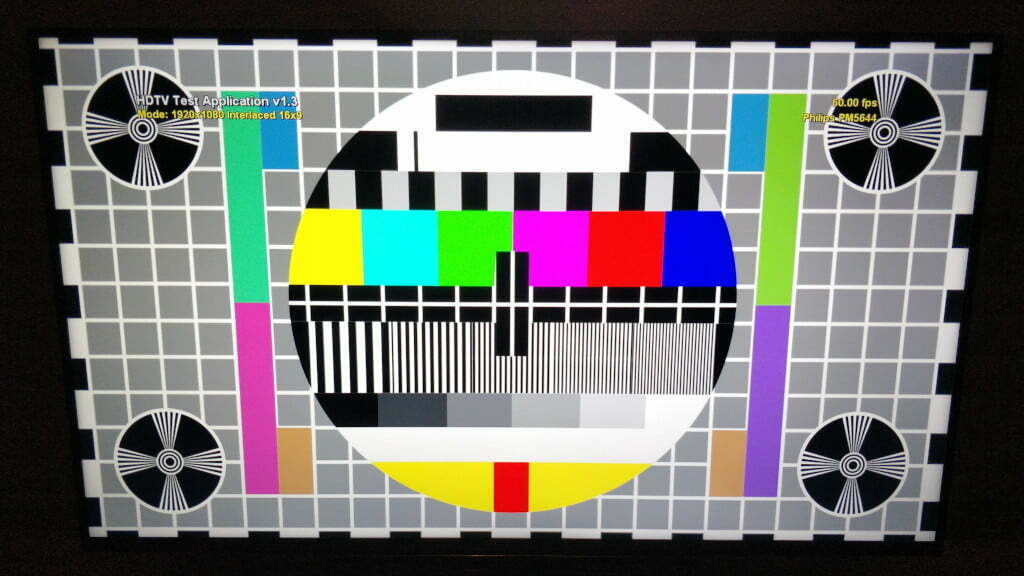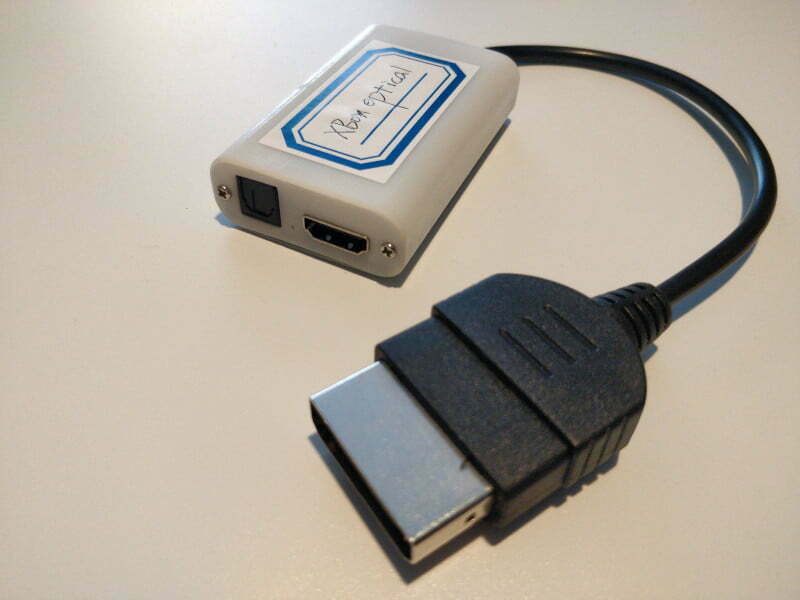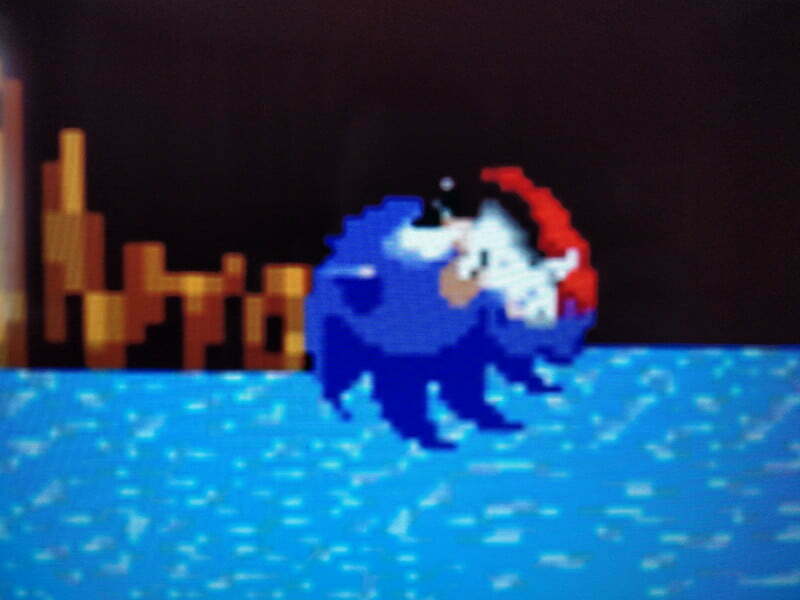A few days ago, I posted about my quest to find a decent HDMI cable for my original XBox. The good folks at Kaico Labs were kind enough to send me a demo unit of their new Xbox to HDMI + Optical cable. I agreed to give them feedback - and they were happy to let me blog about it.
It is important to note that this is a demo unit. I don't know how much, if anything, will change before it gets released. Nor do I know the cost. Adjust your expectations accordingly!
Video
Firstly, I'm pleased to say that it works! Colours are crisp and bright. Picture is stable with no noticeable noise or wobble. I'm sure that if you sat with your nose to the screen, you'd find the odd compression artefact, or fuzzy pixel. But you're playing 20 year old games with the TV on the other side of the room. You aren't going to notice anything distracting.
Here's Buffy:

Ok, it's hard to tell quality from a photo taken of a monitor - but I was impressed with the picture given both the age of the game and the console.
Here's the original Sonic The Hedgehog, running on an emulator:
My Xbox is chipped and pumps out widescreen 720p. The Kaico cable handled all the video I threw at it. 480i, 576i, 720p - they all came out beautifully. Well, as beautiful as upscaled 480i can be! The interlaced modes are always going to suffer - there's just not enough quality in the original image to make things look great. Once you force into progressive mode, things are much clearer.
Only a few games use 1080i - but using Crunchbite's HDTV Test Application 1.3 I was able to verify that the box handles that video mode very well:

Again, photos of screens are no substitute for seeing things yourself. And, obviously, there are diminishing returns to this sort of thing. No amount of video trickery is going to make Super Monkeyball Deluxe look photorealistic.
But for playing back original XBox games, emulated retro-consoles, and the occasional DVD - this is about as good as you can get without tapping directly into the GPU. There's no lag in the video, no static, banding, or other gremlins. Obviously you're limited by what the original console's video fidelity was - but this is about as good as it gets.
Upscaling
I'm happy to say there is no upscaling! When playing the original Buffy, my amp reported that it was receiving 720x576i @50Hz YCbCr444. That's exactly what the game was designed to be played at. You can have your amp or TV do any upscaling or post-processing that you want. It's great that the Kaico doesn't introduce anything that wasn't already there.
Audio
Stereo audio is handled well. Sound was loud and clear. I'm not going to get into an audiophile discussion of the sound-stage and sonic intensity. The MP3s and FLAC files I played had great stereo separation with no noticeable distortion.
But… it is only stereo over HDMI. Even when playing video files with 5.1 Dolby Digital or DTS audiostreams, it only produced stereo. That's a real shame. There is, however, a way to get surround sound…
Digital Audio
There is optical out - it's the standard S/PDIF / Toslink port. Shove an optical cable in there and you will get digital audio.
Both DD and DTS were passed through without issue and with no noticeable delay. The synchronisation between audio and video was fine. There were no click or pops. Just brilliant audio fidelity. My amp reported that Xbox games were being delivered with 48kHz 5.1 Dolby Digital. Again, as with video, the cable doesn't manipulate the audio - it just passes it through.
Thanks to Illtud Daniel for his kind donation of an optical cable!
Downsides
There are a few things that are worth knowing before you splash the cash.
There's a green LED which illuminates when the console is on. And it is very bright. I'm not quite sure what the point of it is - but you may want to tuck it away.
However, this might be a result of this demo unit's plastic case. Their regular cases are metalic so this might be fixed by the time it ships.
The HDMI doesn't support CEC. Normally, when I turn on my PS4 or Switch, my amp receives the CEC signal and turns on itself and the TV. Or, if it is already on, it flips to the correct input. Sadly the Kaico doesn't do that - so you'll need to dig out your TV's remote control.
In a similar vein, widescreen detection seems a bit iffy. Some games do support widescreen - but you might have to manually adjust your TV's "zoom" function. I don't think this is the cable's fault - between the ancient hardware, the third-party BIOS, and weird emulators I've installed it would be hard to track down a culprit.
There is a tiny bit of colour shifting on very dark scenes on interlaced video. For example, the start of the Star Wars Lego games features a black screen with lots of stars. The black background occasionally had a little bit of red or green shift. How much of that is due to the original video compression is hard to say. And, in truth, you have to be looking really carefully to notice it while actually playing a game.
As with all these cables, the picture is slightly dark - as this greyscale test shows:

But you have to remember the original Xbox was designed for CRT TVs which were much brighter than modern TVs. But, once again, a quick tap on your remote and you can tweak your screen's brightness.
The only really annoyance is the lack of bitstreaming over HDMI. I can't quite understand why they didn't just mux the audio into the video rather than providing a separate optical port. I know this is possible because the Electron Shepherd circuit can combine the audio and video.
Teardown!
It wouldn't be a proper blog post if I didn't show you some circuitry, right?

It has a 24.576MHZ crystal and... not much else identifiable! There's a a RetroScaler board with a similar part number.
The internal cabling doesn't look terribly neat and are secured with a big spludge of white gunk.
 But, do remember that this is a demo unit. The production version may be a bit neater.
But, do remember that this is a demo unit. The production version may be a bit neater.
It looks to me - and I'm no expert - that it's a modified version of the Bitfunx's OEM board. See other Xbox HDMI boxes like this:




I couldn't identify the video chip in the Kaico. But it sure looks like the MS9288A. That explains the lack of digital audio - the chip simply doesn't support it. So this board routes the S/PDIF lines directly to the optical out. Which is fair enough, I guess.
There's no active or passive cooling - the box got a little warm during use, but didn't suffer any problems over a several hour gaming session.
Verdict
If you want to resurrect an old Xbox, this is great. Truly just plug and play. Video quality is excellent. Sound is perfectly find if you're content with stereo.
If you want surround sound, you'll have to hook up the optical port and hope your amp allows an alternate sound source for HDMI video. That's a bit of a faff. My amp only has one optical in and I had to dive deep into the settings to assign it to a specific HDMI input.
They haven't listed a price for the cable - but their converters are typically €25-€45, which is pretty fair.
Remember, you're not going to get the original Halo looking as good as it did when you were 12 and the only thing you had to worry about was when your mum was going to kick you off the "big" 24-inch TV. Your memory plays tricks on you. This cable won't allow you to travel in time - but it's a good substitute.
As I said in my last post, there are a variety of cables which do stereo audio. But this is the only available ready-made box which does digital surround sound. If your amp supports assigning optical to an HDMI input, this is a worthy bit of kit.




What links here from around this blog?